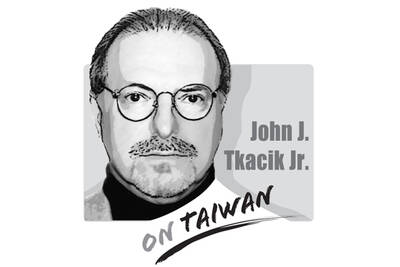During his recent visit to China, former Chinese Nationalist Party (KMT) chairman Wu Poh-hsiung (吳伯雄) said things like “our ancestors had no choice” and that “people on both sides of the Taiwan Strait are ethnically Chinese,” in an attempt to convince the Chinese authorities that he was opposed to Taiwanese independence and wanted unification.
In today’s modern world, it is absurd to consider national identity based on ancestry and blood ties. Wu should be well aware of the fact that when talking about determining nationality based on blood ties or ethnicity, Taiwan is much closer to Singapore than it is to China. Is that what he wants, unification between Taiwan and Singapore?
Research by geneticist Marie Lin (林媽利) at the McKay Memorial Hospital in Taipei shows at least two major sources of Taiwanese ancestry: Austronesia and the Chinese provinces of Fujian and Guangdong. If defining our nation based on ancestry, should Taiwan identify with China, or should it identify with the countries in the Southern Pacific, which are populated by Austronesian peoples?
Wu and those of his ilk will, of course, say that regardless of which ethnic group they belong to, Taiwanese are all part of the Chinese people. This raises the question of whether the concept of a “Chinese people” is a political term or an academic term.
If it is a political term, that would mean it was created to fill political needs.
If it is an academic term, that would mean it has a strictly defined meaning and reference for the purposes of academic study.
Political terms are often redefined as political needs change and this can lead to contradictions over time, while academic terms stand up to the tests of knowledge, experience and logic.
During the revolution in China toward the end of the Qing Dynasty, the revolutionary parties did not consider the Manchus to be Chinese, but once they were overthrown and the Republic of China was born, the new government immediately created the concept of “the Chinese people,” and ethnic groups like Manchus, Mongolians, Hui, Tibetans and so on were all included in this concept.
The term “Chinese people” sometimes includes the Manchus and sometimes it does not. This makes it clear that it is a political term without any ethnological foundation. The process of introducing this term included a lot of ethnocentrism and arbitrary authoritarianism, because other ethnic groups were included under this fictitious umbrella term.
For example, the Uighurs in China’s Xinjiang Province are clearly a Turkic people, distinct from the Han Chinese, judging from their ancestry, language, religion, habits and customs.
If they, who speak an Ural-Altaic language, can be called Chinese, then what about the Kazakhs, Uzbeks and Kyrgyz, who also speak Ural-Altaic languages?
The concept “Chinese people” does not stand up to the test of knowledge. After 100 years of propaganda, the Chinese Communist Party seems to be using this term as a magic spell to suppress peoples and regions with a strong wish for political independence.
It calls everyone who seeks independence, destroyers of the “Chinese people.”
If Taiwan wants to identify with this fictitious creation, it will have to sacrifice its position as a prosperous and independent democratic state.
That must be the stupidest idea anyone has ever come up with.
Lee Hsiao-feng is a professor at National Taipei University’s Graduate School of Taiwanese Culture.
Translated by Perry Svensson
You wish every Taiwanese spoke English like I do. I was not born an anglophone, yet I am paid to write and speak in English. It is my working language and my primary idiom in private. I am more than bilingual: I think in English; it is my language now. Can you guess how many native English speakers I had as teachers in my entire life? Zero. I only lived in an English-speaking country, Australia, in my 30s, and it was because I was already fluent that I was able to live and pursue a career. English became my main language during adulthood

Somehow, US intelligence identified “the Houthis’ top missile guy” and pinpointed his exact location. At 1348 hours (Washington time), March 15, President Trump’s national security advisor Mike Waltz texted, “positive ID of him walking into his girlfriend’s building.” The unsuspecting Romeo entered. High above, the drone monitoring the building registered a flash. When the smoke cleared, Mr. Waltz texted, “…And it’s now collapsed.” RIP. The star-crossed “top missile guy” had been target number one in the now uproarious US Navy bombing campaign on that Sunday against the Yemeni rebels who have been holding the Red Sea hostage since October 19,
Taiwan on Monday celebrated Freedom of Speech Day. The commemoration is not an international day, and was first established in Tainan by President William Lai (賴清德) in 2012, when he was mayor of that city. The day was elevated to a national holiday in 2016 by then-president Tsai Ing-wen (蔡英文). Lai chose April 7, because it marks the anniversary of the death of democracy advocate Deng Nan-jung (鄭南榕), who started Freedom Era Weekly to promote freedom of expression. Thirty-six years ago, a warrant for Deng’s arrest had been issued after he refused to appear in court to answer charges of
The Opinion page has published several articles and editorials over the past few weeks addressing Taiwan’s efforts to leverage unique or strong aspects of its culture to increase international awareness of the nation. These have included submissions by foreign journalists and overseas students, highlighting how bubble milk tea, Guinness World Record attempts, the entertainment sectors, impressive scenery, world-class cuisine and important contributions to the high-tech supply chain can enhance Taiwan’s recognition overseas and therefore its soft power. That entails competing for attention in already crowded sectors. Other nations, after all, offer popular entertainment exports, beautiful scenic spots and great food.